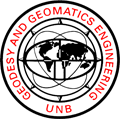David E. Wells - Career Summary
In 1965, with an education in nuclear physics, I joined the Bedford Institute of Oceanography as an electronic design engineer. Ross Douglas (a future Dominion Hydrographer) and I formed the first Canadian Hydrographic Service "development group". I was also responsible for BIO's first two seagoing computers (Digital Equipment PDP-8), and two newly declassified Navy Navigation Satellite System (Transit) receivers.I programmed algorithms for a least squares position fix based on Transit measurements, in machine language on the PDP-8 computers. It was tough squeezing this into the PDP-8's 4K memory. Two BIO colleagues, Dave Dalby and Bob Ross, and I wrote the double-precision cosine and square root functions needed for the PDP-8. Digital Equipment Corporation adopted our functions for all their customers.
Because I didn't understand some of the geodetic concepts involved in the Transit fix algorithms, in 1970 I jumped at the chance to study for a PhD in geodesy at the University of New Brunswick. After finishing my dissertation, pretentiously titled "Electromagnetic Metrology, Hilbert Space Optimisation and their Application to Doppler Satellite Control", I returned to the Bedford Institute and joined the Navigation Group, led by Mike Eaton. Over the next few years, Steve Grant and I programmed BIONAV, an integrated navigation software package (25,000 lines of Fortran code) used on BIO ships.
I also became involved in high latitude use of Transit, north of Alaska with the AIDJEX project, and in 1979 at the North Pole with Project LOREX. As I was preparing for LOREX, I received a call from Petr Vaníček at UNB, asking if I would be interested in an academic career. I said no. I was too interested in my work at BIO. But Petr persisted, and eventually I sent an acceptance letter to UNB, from the North Pole.
Soon after arriving at UNB in 1980, I became interested in GPS. Many Canadian geodesists were working together on early problems with GPS. In 1986 I led 10 colleagues from UNB, the University of Calgary, and the Geodetic Survey of Canada in preparing the "Guide to GPS Positioning", which sold over 12,000 copies (it is still available from Amazon.com).
In 1988 the Canadian Hydrographic Service was facing the serious problem of dealing with millions of soundings generated by multibeam sonar echo-sounding systems. I was asked to establish an Ocean Mapping Group at UNB to tackle this problem. Colin Ware and I produced a conceptual plan for dealing with these data using software "power tools" and data visualisation. I supervised the development of prototype software which evolved into CARIS HIPS.
By 1991 together other UNB fundraisers, we had raised $1.5 million dollars from the CHS and others to support a UNB Chair in Ocean Mapping, and were able to attract Larry Mayer and John Hughes Clarke to join the Ocean Mapping Group.


